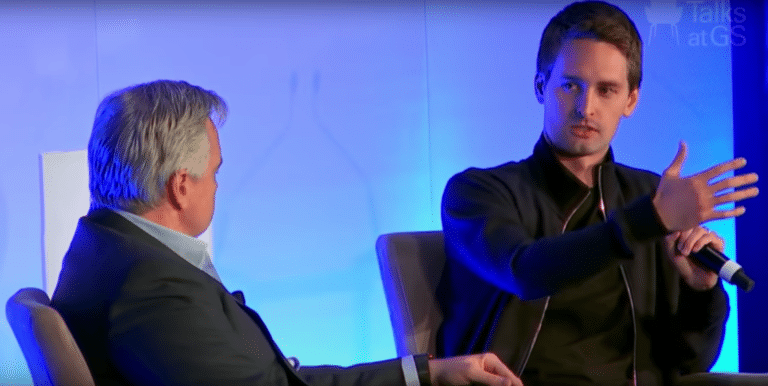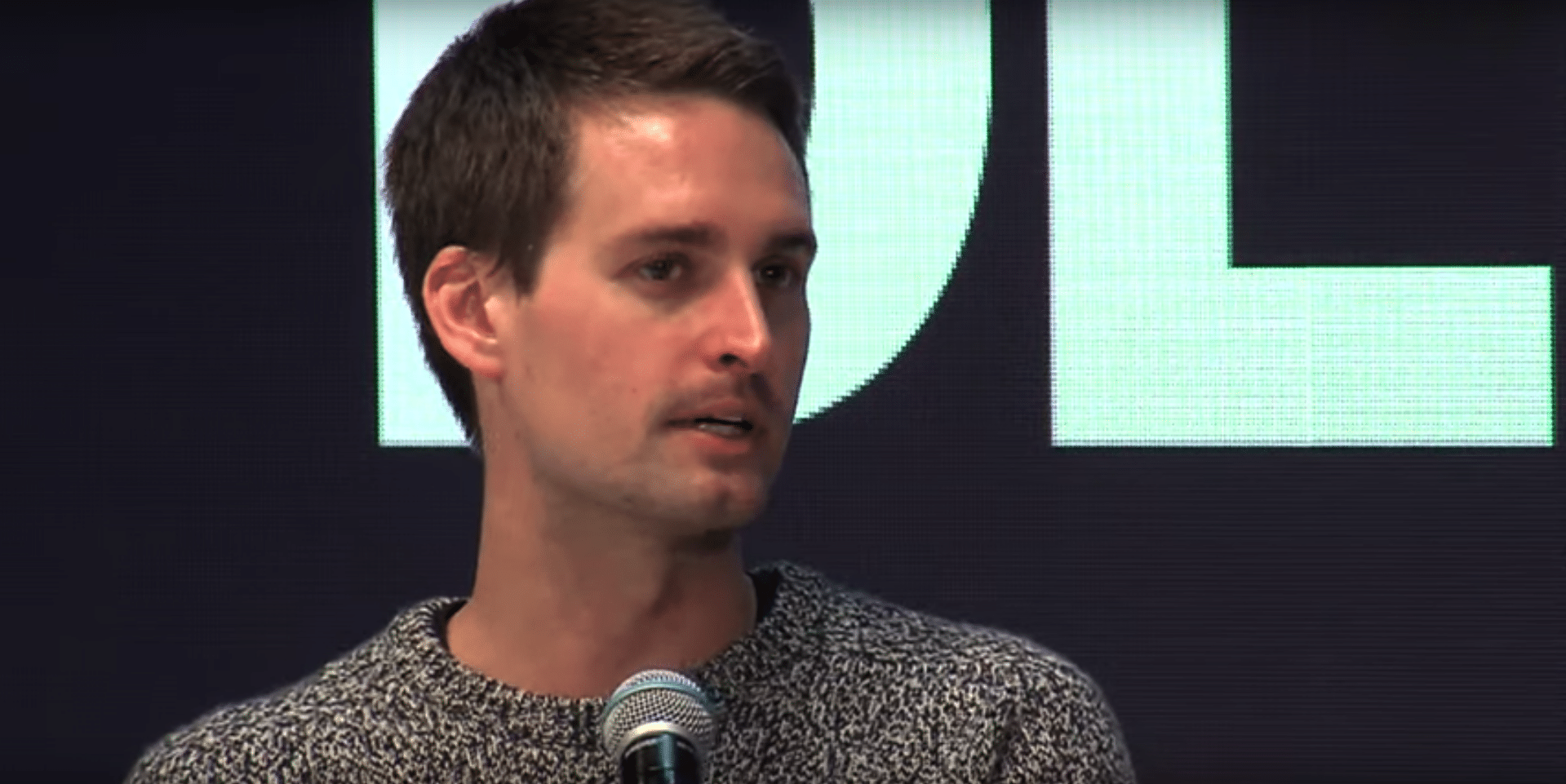
XR Talks is a series that features the best presentations and educational videos from the XR universe. It includes embedded video, as well as narrative analysis and top takeaways. Speakers’ opinions are their own. For a deeper indexed and searchable archive, subscribe to ARtillery PRO.
Snapchat is the engagement and revenue leader in consumer AR. This is driven largely from the high-frequency usage it’s been able to achieve for AR lenses, and its ability to monetize them. Broadly, this stems from Snap’s AR focus and alignment with its core “camera-company” ethos.
Its strategies and best practices were recently unpacked on more granular levels in an ARtillery Intelligence report. But it’s also worth panning back to a 40,000-foot view for Snap’s driving principles and philosophies. So we’ve assembled a “triple-shot” of Evan Spiegel video clips.
Broader Canvas
One notable factor in Snapchat’s current AR trajectory is its transition from whimsy to utility. It will continue to cultivate the highly-viral social lenses that have erstwhile fueled its AR traction and revenue. But it’s also now expanding into utilitarian functions, as we’ve examined.
This extends beyond front-facing (selfie) camera lenses to more rear-facing camera activations to augment the broader canvas of the physical world. It also extends beyond lenses altogether with things like visual search, to identify products (via Amazon), or do things like solve math problems.
“One of the things that’s really exciting about augmented reality today is that it’s being used primarily for self-expression,” said Spiegel at the DLD Summit (video below) “So people are using hundreds of thousands of lenses that have been created by our community to express how they feel […] But very rapidly, augmented reality is starting to serve a more utilitarian use case. So one example on Snapchat today is you can press and hold on a math problem and Photomath will solve that math problem for you. So I think you’re starting to see some of these use cases for augmented reality evolve beyond just creativity, fun and entertainment.”
The Business Side
One of the things that these feature expansions will accomplish is to create new use cases. This will in turn grow the user base as well as the engagement frequency of existing users. Snapchat already achieves an impressive 30 lens views per-day on average from active users.
This gets into strategic territory when viewed in ad inventory terms. In advertising economies, usage of a given media product is supply, while advertising is demand. The above product evolution continues to boost the supply side, but Snap’s business objective is now to blitz demand.
Its revenue growth (including AR) and 2019 stock market rebound have been substantial, so this shift will only mean more growth. In fact, this supply/demand equation bodes well in that supply currently outweighs demand and it has lots of ad inventory (user engagement) to sell.
That will unfold in a deliberate strategy that follows best practices and industry standards in ad sales This includes things like segmenting sales units into vertically-focused teams, and other moves that represent Snap’s ongoing maturation as a publicly-traded advertising business.
“Because our business is so new and young, if we look at the revenue growth at least in the near term, the next few years are more closely correlated with advertiser growth — spend growth and active advertisers,” Spiegel said Goldman Sachs’ Talks at GS (video below). “And that’s because we have so much engagement. We have so much supply. So that’s something that we’re really focused on as a business. This year we reorganized our sales force so now that’s verticalized and can go really deep with advertisers. But we’ve also improved the platform such as ‘Instant Create’ to help the long-tail of advertisers to advertise on Snap. […] I think the business, the way it’s been structured over the last 7-8 years, has been focused on the supply side and that’s obviously what’s difficult to build in our industry. So we’ve been really focused on growing users and growing engagement, and now we’re going to continue to do that but also learn how to grow the demand side of the business.”
The Long Game
All of the above accomplishes real revenue performance today. But it also doubles as a strategy to cultivate the soil for a longer-term AR play. The first clues of that vision can be seen in Spectacles, which aren’t AR glasses but do advance Snap’s AR play by gathering demand signals.
Spectacles are also a conditioning play. Just like Apple’s approach to pave the way for an eventual AR glasses product with today’s products (wearables, ARkit), Snap wants to get users comfortable with sensors on their faces. That way, eventual AR glasses hit the ground running.
“Spectacles represent a long-term investment in augmented reality hardware,” Speigel said at TechCrunch Disrupt. “So I think it’ll be roughly ten years before there’s a consumer product with a display that could be really widely adopted. But in the meantime, we’ve built a relationship with our community and all these people who love building [AR] experiences and we’re sort of working our way towards that future, rather than go in a hole or in an R&D center, and try to make something that people like, then show them ten years later. We’ve sort of created a relationship with our community where we build that future together. So I think what’s really cool about Spectacles 3, for the first time we have depth capability and if you’re using Lens Studio, which are our tools for building augmented reality experiences, you can build AR directly for that spectacles content in 3D using our depth technology. So that’s sort of an iterative step towards this AR future.”

Seeding the Experience
This live market experimentation is notable in that it deviates from other approaches, such as Apple. Snap also deviates from other tech giants in that it’s not spending nearly as much on R&D (consider Facebook). It’s rather iterating the product in the wild through live market feedback.
That goes beyond spectacles and comes back to its “here and now” mobile AR activity. Just as spectacles will condition tomorrow’s users for more advanced AR glasses, Lens Studio is in the process of conditioning developers to think spatially. And that will be a key evolutionary step.
“I don’t necessarily think outspending is a strategy that works over a long period of time,” said Spiegel at the same TC Disrupt conference (video below). “So we’ve taken a little bit of a different approach when it comes to augmented reality, and that’s by starting today with the tools that we have. So today, we have an application that opens right into the camera. We’ve got 200-some million people using our camera everyday. And as part of that, we have all these AR tools and ways to express yourself. Anyone in the world can build an AR experience and deploy it immediately to our community. To date, there have been 500,000+ lenses created. So by seeding that experience — even though today’s AR experienced is this tiny little screen on your phone — by the time the hardware gets there ten years from now, we’ll have a thriving ecosystem of experiences.”
For deeper XR data and intelligence, join ARtillery PRO and subscribe to the free AR Insider Weekly newsletter.
Disclosure: AR Insider has no financial stake in the companies mentioned in this post, nor received payment for its production. Disclosure and ethics policy can be seen here.
Header image credit: Goldman Sachs, YouTube


